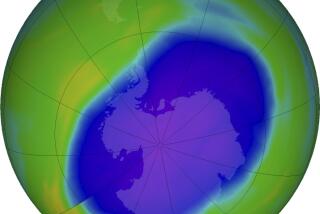Science / Medicine : Ozone Hole Damages Food Chain
- Share via
The expanding hole in the ozone layer above the South Pole is significantly reducing the growth of phytoplankton--minute floating plants--that form the foundation of the Antarctic food chain, researchers reported last week. The effect is the first direct evidence that the abnormally high levels of ultraviolet light coming through the ozone hole is having an impact on Antarctic populations, said geographer Raymond C. Smith of UC Santa Barbara, who headed the team.
The Antarctic ozone hole, which was first detected in 1979, is the strongest evidence that the Earth’s protective ozone layer is being damaged by chlorofluorocarbons used in refrigerators, air conditioners, foam insulation and the electronics industry.
In 1990, the team studied phytoplankton in an area of the Bellinghausen Sea, where the edge of the ozone hole swept back and forth repeatedly during the six-week study. They reported last week in the journal Science that the growth rate of the phytoplankton decreased by 6% to 12% during periods when the hole was over them and they were exposed to greater amounts of damaging ultraviolet light.
They estimate that this corresponds to a 2% to 4% decrease in yearly phytoplankton growth in the Antarctic. Decreased amounts of phytoplankton would lead to decreases in the number of fish.





